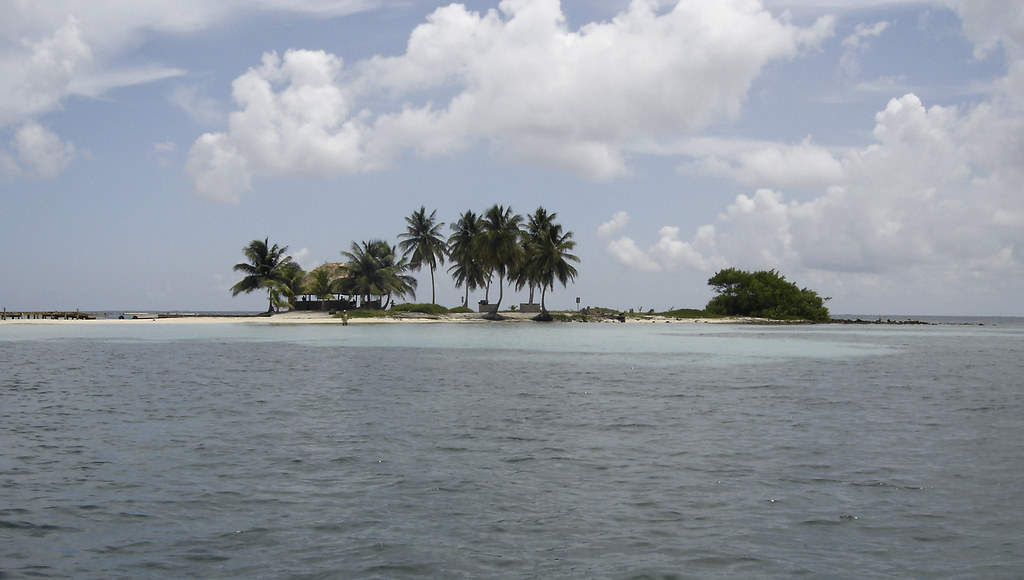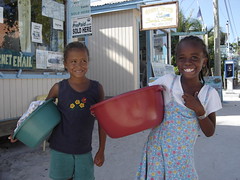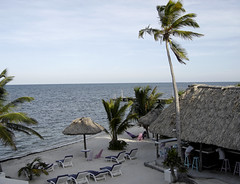
By Heidi Price
AMERGRIS CAYE, Belize – I have three sisters who work as flight attendants, all veteran travelers, all with differing views on what constitutes a getaway.
The eldest and most traveled among us is clear – she wants luxury, time away from the everyday intrusions of reality. The youngest enjoys lying on a beach, going out at night and shopping in all its forms.
So I invited, Julie, older than me by two years and a wanderlust at heart, to join me on a trip to Ambergris Caye, an eco-touristy island off the coast of Belize that offers spectacular diving and snorkeling, but little in the way of shopping – except young children who roam the streets, barefoot, selling cinnamon rolls their mothers baked for 50 cents, who are shown below:

We set our departure date for early September 2004. Several travel Web sites and books warned that this was the high noon of hurricane season and going anywhere near the Caribbean was a mistake. But I was looking forward to exploring Belize's barrier reef – 185 miles of coral caverns and colorful fish, second only in size to Australia's Great Barrier Reef.
Armed with my Lonely Planet Guide Book – in my opinion the most comprehensive among travel guides – I began perusing hotel Web sites. After several hours, I found my best deal, Mata Rocks, which offered five nights for $230 per person. The price included a continental breakfast each morning, bicycle rentals and one diving and/or snorkeling trip.

Touching down
On Sept. 6, our plane touched down in Belize City. Two air taxis also offer connecting flights from Philip Goldson International Airport, but my sister suggested we take the water taxi, which leaves hourly from the Belize Marine Terminal in the center of Belize City. We purchased two round-trip tickets for $55, and soon we were gliding over crystalline blue waters. More than an hour later, we approached a small dock in San Pedro, a small town on Ambergris Caye and the inspiration for Madonna's song "La Isla Bonita."
I was surprised. With Hurricane Frances winding down and Ivan rumbling toward the Caribbean, I thought the streets would be empty. Instead, they were crowded with honeymooners, divers and residents, all traversing the dusty streets in golf carts, bicycles or on foot. The only vehicles I saw during my stay were taxi cabs and the occasional delivery truck.
Beyond its reef, Belize is an unsophisticated, unspoiled home to manatees, marine reserves, caverns and, farther inland, near the Guatemalan border, ancient ruins. As the country, formerly British Honduras, celebrates its 23rd year of independence, it faces an identity crisis: maintain its unspoiled beauty while playing host to its No. 1 industry – tourism.
One brochure noted that 40 percent of Belize is now protected by reserves. Two such protected areas are just a half mile off the coast of Ambergris Caye: Shark Ray Alley, where you can swim with nurse sharks and Southern Sting Rays in shallow waters, and Hol Chan Marine Reserve, where snorkelers and divers can explore marine life through a cut in the reef more than 30 feet deep.
Underwater travel
Manual, our guide our second day out, spent nearly two hours exploring Hol Chan with us. He swam with us the entire time, teaching us how to find sea pearls, identify tropical fish and clean our masks with sea grass so they wouldn't fog up. Manuel, who is of Mayan descent, knew his marine biology, not leaving until he had shown us every fish on the reef including a Yellowtail Damsel fish, my new favorite.
On the way to explore another site, Manuel stopped his boat to show us a "Laggerhead" snapping turtle, which he estimated was 80 years old and I estimated to be about the size of a Mini Cooper.
Several of our day trips included stops in Caye Caulker, a neighboring island brimming with twentysomethings and $5-a-night room rates. Most tourists on the island converge at the Lazy Lizard, a watering hole on "The Split," a gash where Hurricane Hattie split the island in two in 1961.
One afternoon, while exploring Front Street, my sister tried to knock a coconut out of a tree. A man watching from his front porch held up a finger signaling us to wait, and five minutes later we were drinking fresh coconut milk out of two coconuts in which he had drilled holes.
I found that type of warmth and response from everyone we met during our weeklong trip with one exception: a diving instructor, the only one we didn't book through our hotel, who stole my sister's camcorder. We thought it was lost, but I was amazed to receive an e-mail from our hotel a few weeks after our return stating that a security guard who we befriended at the neighboring hotel had "recovered" the camcorder.
I recommend going out with well-established businesses that have long-standing relationships with your hotel.
Daily excursions
One of the best trips, and one arranged through Mata Rocks, was a daylong excursion to see Indian manatees in a protected reserve near Belize City. According to our guide, manatees were once hunted for their ivory, but with a concerted effort, these 1,200-pound creatures are now a protected species and can spend their days eating, resting and, in September, mating.
After, we explored the reef around Goff's Caye, our guides grilled on the island and then took us to a popular habitat for sea horses, a few feet off the coast of Caye Caulker.

We spent another day riding our bikes around the island, visiting the "Living Arts" museum, an outdoor exhibit run by Sean and Jose, who oversee the assemblage of artwork made from abandoned flip flops, driftwood and skiffs found on the island. The museum, a difficult find down an overgrown lane, was free, but Sean bet me $5 that he could wrangle a kiss from Panchito, the museum monkey.
Sean and Jose, like many residents I met on the island, are expatriates. In "Adapter Kit Belize," Lan Sluder wrote that Ambergris Caye is home to the largest concentration of expatriates in Belize.
Most nights we rode our bikes into San Pedro. As the country geared up for its independence day celebration, Sept. 21, children practiced and would happily teach you the Punta, a hip-shaking dance to a rhythmic beat.
Every evening around sunset, tourists gathered at the water plant, about a mile south of San Pedro and not far from our hotel, where a very brave soul would bring out a chicken to feed the crocodile. It always drew a crowd.
"Finding tarantulas and scorpions, that's normal," said Jenna Brandt, 29, a New Jersey native who lives in San Pedro while studying at Medical University of the Americas. "Sometimes, you'll find snakes on the street, pythons."
And while Brandt plans to return to the states after medical school, she's enjoying her life in Belize.
"I love the fact that life is so simple. The locals have such simple lives, their lives are humble," Brandt said.
